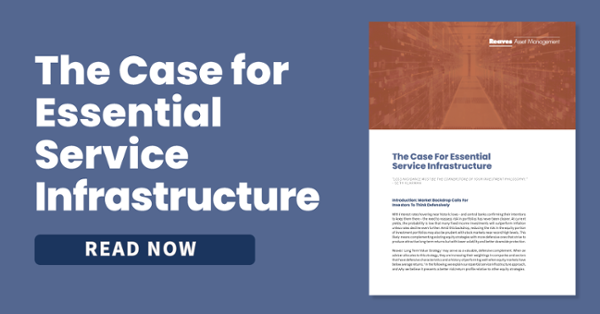Most companies in the Reaves universe of essential infrastructure companies have now reported earnings for the final quarter of 2021. Having reviewed the financial results and listened to the commentary shared by management teams on conference calls, our investment team members made a number of observations which we have summarized in this blog post.
Overall, earnings results from utility companies met or exceeded expectations. Forward earnings and dividend guidance for most companies was either affirmed or increased. More than a dozen companies stated their confidence in attaining EPS growth in excess of 5% this year.
Capital spending plans are increasing at many utility companies which we view as a potential positive tailwind for the sector. In addition to the renewable investment projects we have written about in a previous blog, companies are also focused on strengthening transmission through grid resiliency projects in the wake of increasingly severe weather events. For example, on their earnings calls, several Gulf Coast utilities mentioned that there is an unusually high level of stakeholder support for this type of spending, including support from politicians and regulators, a notable change from several years ago.
Demand for electricity increased at several companies, reflecting a strengthening post-COVID economy. In addition, demographic trends and other factors continue to boost customer growth in states such as Florida and Texas. Utilities in Arizona and Oklahoma also experienced higher than normal growth in electricity usage.
Several companies announced the sale of non-regulated assets which simplifies their business structures, a strategy we believe will be constructive for valuations. Exelon Corp. completed the spin-off of its generation business into a new publicly traded company, Constellation Energy Corp.1 Consolidated Edison and American Electric Power Company Inc. both announced intentions to explore the sale of non-regulated, contracted renewable assets with sales proceeds being redeployed in their regulated utility businesses.2
Inflationary pressures were only modestly evident in earnings reports and some companies remain focused on keeping non-fuel expenses flat in the year ahead. Supply chain issues have had some impact on renewable generation projects, and we will watch developments in this area closely. We expect management teams at utility companies to remain closely focused on keeping customer rate increases in the next few years below the rate of inflation.
Among communications infrastructure companies, data center and tower companies delivered very strong reports and made positive comments about their future growth. Underlying fundamental demand continues to be extremely robust and we believe that the strong flow of private capital into these types of businesses reflects ongoing recognition of the growth potential and critical importance of the underlying assets to the modern economy.
We continue to favor interconnection-focused data centers where enterprise demand for connectivity and computing services remains strong. Supply and demand appear to be well balanced across most geographies in spite of more competition from new privately held operators. Revenue from both new and existing customers is being driven by demand for network and cloud access in ever more geographies.
Qualitative commentary from large, domestic tower operators this reporting season was highly encouraging. Most companies we heard from cited the greatest level of customer activity they’ve seen in either years, decades (going back to peak 3G and 4G technology deployment), or even in some cases, since the advent of the wireless industry. Quantitatively, growth in new leases is forecast to accelerate into 2022 and possibly 2023 as well. As established carriers deploy large swaths of spectrum, either acquired at recent auctions or through industry consolidation in the case of T-Mobile, towers receive increased rental revenue via amendments. Likewise, now that nascent wireless operator DISH Network has finally begun to build its network from scratch, colocation revenue is rising. Fundamentally, this is a powerful combination which should support future growth.
For the cable/broadband companies, it is our view that there is a current disconnect between the strong financial performance reported by the companies and the relatively weak performance of their common stocks. We believe that many investors remain overly focused on the slowing rate of growth in the number of broadband subscribers and are overlooking improving margins and continued growth in critical metrics such as revenue and free cash flow.
We continue to monitor closely emerging competitive threats from some telecom companies to cable’s dominance in broadband services but believe the long-term impact will be less than feared. We note the success of cable companies in growing their market share in the wireless business and heard nothing in this quarter’s earnings reports that diminished cable’s cost advantages versus telecom companies. We expect cable operators to continue to exploit these advantages in the years ahead.
Finally, the industrial real estate companies we follow communicated that, as we move out of the pandemic, demand for warehouse space remains very strong and will most likely continue to outstrip demand in 2022 despite an increase in new construction. The driver continues to be increasing adoption of e-commerce, by both companies and end users, as share is taken from traditional brick and mortar businesses, a theme we expect to continue.



